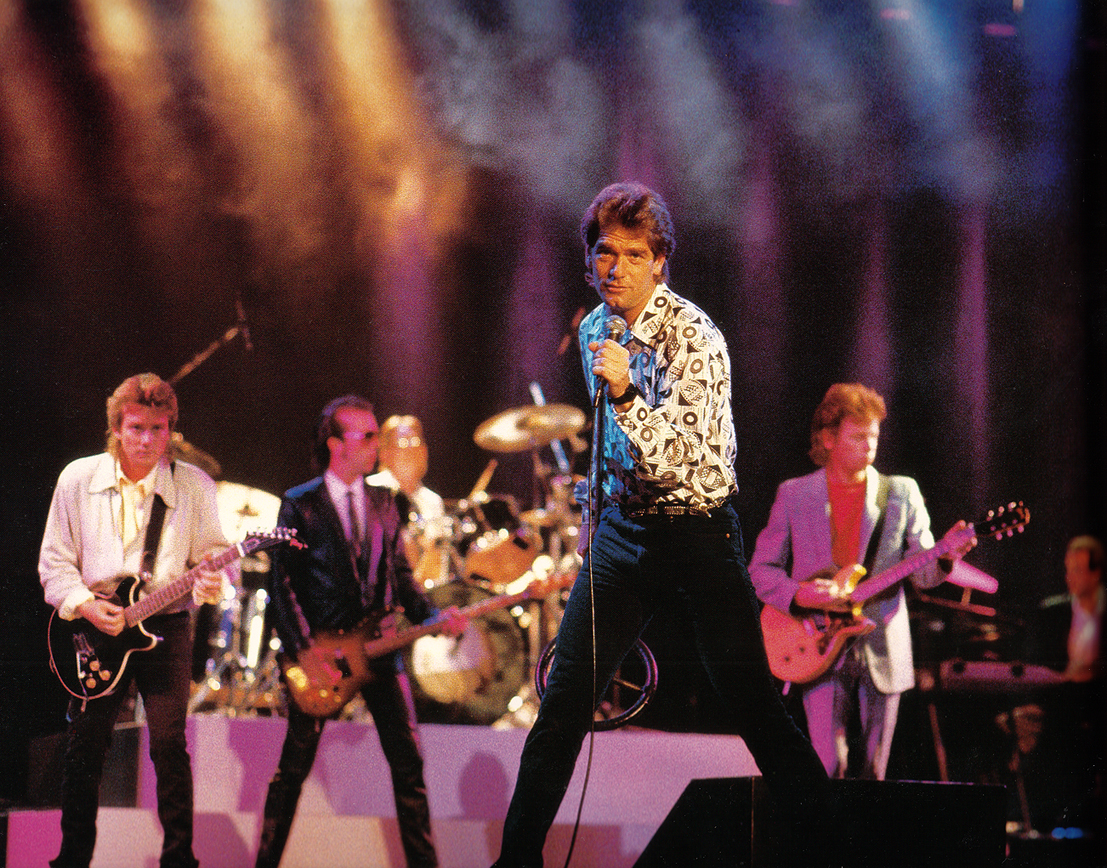
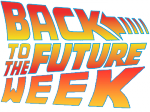 Over the past week, the Overthinking It team has subjected the Back to the Future trilogy to a level of scrutiny it definitely deserves, pointing out a wide variety of paradoxes, inconsistencies, and unanswered questions regarding the series. Because these analyses have focused on the logical, metaphysical, and technological aspects of time-travel within the plot of the three BTTF movies, they haven’t touched on what I consider to be one of the most interesting puzzles in the series:The Huey Paradox.
Over the past week, the Overthinking It team has subjected the Back to the Future trilogy to a level of scrutiny it definitely deserves, pointing out a wide variety of paradoxes, inconsistencies, and unanswered questions regarding the series. Because these analyses have focused on the logical, metaphysical, and technological aspects of time-travel within the plot of the three BTTF movies, they haven’t touched on what I consider to be one of the most interesting puzzles in the series:The Huey Paradox.
The Huey Paradox is jointly produced by two features of the BTTF trilogy: the overwhelming number of references to Huey Lewis throughout Back to the Future, along with his near absence in the other two films in the series. Songs by Huey Lewis and the News are the first and last music that you hear in part one of the trilogy: Marty listens to “The Power of Love” as he skateboards to school (and again after getting a kiss from Jennifer under the clock tower), and “Back in Time” plays on his clock radio the morning after he returns from 1955 (and is reprised over the end credits). In addition, Huey Lewis himself makes a brief cameo as one of the high school teachers who deems Marty’s band “too loud” to play at the school dance, cutting off their instrumental noise-metal rendition of “The Power of Love” after about 30 seconds. Huey also reappears briefly as a fedora-wearing man who briefly stares at Marty’s “life preserver” puffy vest in 1950s Hill Valley.
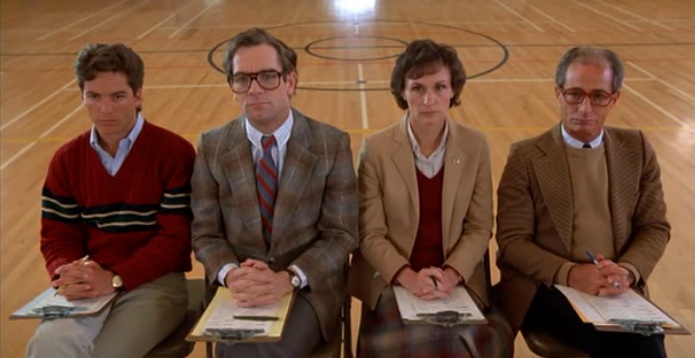
Is it really so hip to be square?
In many ways, using Huey Lewis and the News as a shorthand for 80s popular culture was an inspired choice by the filmmakers; by the early 80s the band had really come into their own, commercially and artistically. The band’s sound and on-stage personas managed to tie together the three of the biggest elements of early eighties pop music: the Soft-Soul of artists like Hall and Oates, the synthesized sheen of new wave, and many of the classic hard rock influences that informed their spandex-clad pop metal contemporaries. The amalgamation of these three musical elements led to the critical and commercial success of their 1983 release Sports, and even inspired Ray Parker Jr. to rip off one of their melodies for the Ghostbusters theme song (eventually leading to a lawsuit and settlement in favor of Lewis).
The selection of Huey Lewis as a representative element of 80s pop culture in Back to the Future was also a self-fulfilling prophecy: on the strength of their inclusion in the film, both “The Power of Love” and “Back in Time” became hits in 1985, giving Lewis his first #1 single on the Billboard Hot 100. On the strength of these singles, the band’s next full-length album, Fore! became a mega-hit, reaching the top of the Billboard albums chart and producing five top ten hit singles.
Given Huey Lewis’s prominent placement in Back to the Future, and the role that the film had played in his chart dominance in 1986 and 1987, it would have been logical to expect more Huey in Parts II and III of the series… maybe another theme song or four, a few more period-relevant cameos, another music video tie-in? Instead, almost all evidence of Lewis’s association with the franchise is erased in the sequels: in Part II, the 2015 version of Marty plays a barely recognizable version of the chord progression to “The Power of Love” after getting fired for engaging in white collar crime, and at the end of Part III, Needles is listening to the song in his truck when he challenges Marty to a drag race.
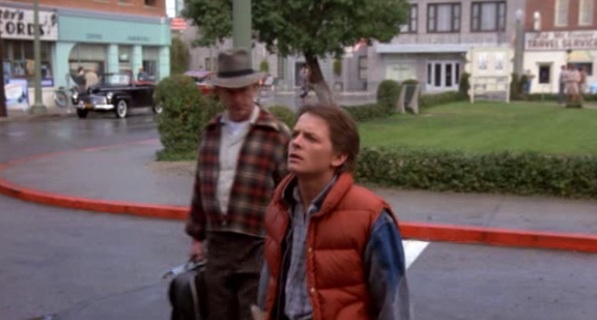
Huey didn't even know how good he had it. By 1989, he would kill for even a walk-by cameo.
Why is Huey Lewis inescapable throughout much of the original Back To The Future, but nearly absent from the other two movies in the series? The underthought answer is that because the last two movies in the series spend very little time in the 1980s, there is simply no opportunity to bring in Huey Lewis in those films. However, Lewis’s appearance in the first installment isn’t limited to the appearance of his songs as diegetic music in 1980s Hill Valley: Huey himself has a cameo as a resident of the 1955 version of the town. Moreover, 1980s pop culture manage to make their way the depictions of both 2015 and 1885 by way of the nostaglia-driven 80’s cafe in Part II and the appearance of ZZ Top as the hoedown band in Part III.
Instead, the main reason that Huey Lewis disappeared faster than Marty’s brother’s head is that the popular culture had already moved on in the four years following the release of Back to the Future. By the time of the release of BTTF Part II in 1989, “The Power of Love” was already old news and Small World, the band’s follow-up to Fore! flopped commercially. Indeed it is telling that even by 1988, Huey barely cracked the Hot 100 or the Modern Rock charts, instead achieving his biggest chart success on the Adult Contemporary chart. Although the rise of alternative rock in the early 90s was the final nail in the coffin, by 1989 it already seemed that Huey’s pop culture relevance would be limited to the nostalgia industry and roles in movies about karaoke hustlers.
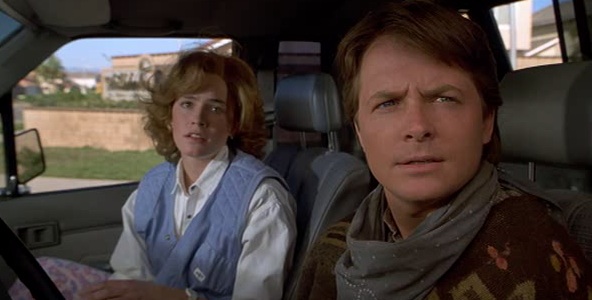
You listen to Huey Lewis? In 1990? Really?!?
And yet, pop cultural time doesn’t always move in a neat, unilinear way. When Seth Rogen and David Gordon Green tapped Huey Lewis to write the theme song for Pineapple Express, it definitely seemed that all of the elements had aligned for a major Huey renaissance. The theme song did receive a bit of attention from music and film blogs, but the real pop culture breakthrough from that film was M.I.A.’s “Paper Planes”, which became a top 10 hit, a YouTube sensation, and earned a Grammy nomination, all as a result of the song’s inclusion in the Pineapple Express trailer. Even though 2008 wasn’t to be the year where Huey Lewis became the king of cool once again, M.I.A.’s unlikely Apatow-driven crossover success managed to carry on the spirit of his 1985 Back to the Future heyday in an unexpected way.
Nice article. Don’t forget the Sports poster hanging on the wall in Marty’s room.
Hypothesis: Brett Easton Ellis was able to use Huey Lewis as a symbol for 80s excess in American Psycho precisely BECAUSE of Lewis’ association with Back to the Future.
Funny how in 2009 Huey is cool again…
@Bill- Do you have evidence about Huey’s contemporary coolness other than this post?
I am fifteen, and I have to admit, Huey Lewis and the news is my absolute favourite band. I am sincerely hopng they get popular again, beccause they are one of the few bands that survived the 80s with lots of fnas. I love them!
Huey Lewis and the News were cool then and actually never stopped being cool, and I opine that they never shall stop being cool. To those who enjoy an upbeat sonic profile mated with positive lyrics about various life situations, this music and the band itself will always remain “cool”. Those who lack the ability to appreciate these finer things in life should turn heel and exit rather than interject negativity into our pleasant conversation.
“I am fifteen, and I have to admit, Huey Lewis and the news is my absolute favourite band.”
You’re forgiven. You’re too young to know what you’re saying.